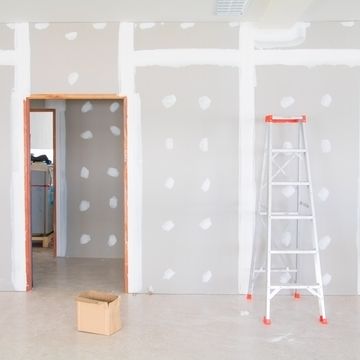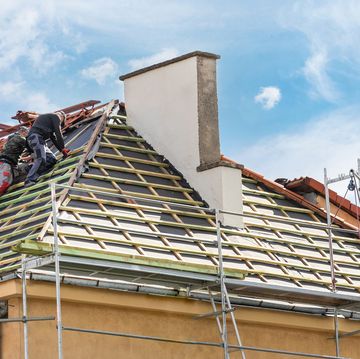Problem #1: Condensation forms along the bottom or corners of the glass.
Your window is trying to tell you: The house is not adequately ventilated, or there is a high moisture level in the home. This is less of a window problem and more of a moisture issue, but your window provides the telltale sign.
The moisture forms as condensation or frost on the windows when the temperature dips below freezing. This can lead to mold, mildew, or rotting wood sills. "It's the perfect environment for mold," says Bob Minoli, president of Integrity Residential Window Repair, near Sacramento, California. "Newer houses are built so tight that any moisture inside will stay there unless you do something to reduce it."
It's a balancing act to reduce the moisture level indoors without having the house too dry, but when you see condensation forming, you can run a dehumidifier, run bathroom fans, or open a single window for about 15 minutes a day to exchange inside air for dry outside air, Minoli explains.
Problem #2: Condensation forms between the panes of glass.
Your window is trying to tell you: The seals on the double- or triple-pane window are deteriorating or have already failed, letting outside air in. Moisture gets trapped between the panes and condenses into droplets or turns foggy.
"The entire window would not have to be replaced," Minoli says. "A moisture-failed panel can be easily replaced with a new one."
Problem #3: Condensation forms in the center of the glass, inside the house.
Your window is trying to tell you: You've probably got a gas leak.
This can be a problem in double-pane, gas-filled windows. The gas, typically argon, leaks out from between the two panes or settles to the bottom of the window, causing the glass to bow inward. In some cases, the centers of the two panes actually touch. "This usually causes a rainbow effect and leaves scratch marks on the inside of the unit where the two panes touch," Minoli says. "This often happens during the manufacturing process."
Once the gas leaks out, the window no longer provides good insulation, which is why the glass gets cold in the winter. "Argon acts as an insulator," Minoli says, adding that replacing the window is the only way to solve the problem, and the issue may be covered under a warranty. "The window may not be ruined; it's sometimes hard to detect when the gas has dissipated over time, but you're paying for what you've lost in insulation."
Problem #4: Your double-hung window is hard to open and close.
Your window is trying to tell you: The wood is swelling.
Wood windows swell when they're damp or air humidity is high, making them tough to operate. When the temperature or humidity changes, the window may work smoothly again. If that's the case, you can gently plane or sand down the wood panes to make them slide easily year-round.
Wood and vinyl windows have mechanisms such as springs under tension to make it easier to open and close them. Minoli says he's seen the mechanisms fail in as little as five years, making the windows difficult to operate. "It's a common issue," he says. "The parts may need to be replaced, and they usually cost $15 to $20." Minoli says that adding a silicon or other lubricant in the sliding track can make the window open and close more easily.
Problem #5: Casement windows won't open and shut easily.
Your window is trying to tell you: Debris is built up in the window track, or the moving parts need to be cleaned and lubricated or replaced. Casement windows require maintenance to operate efficiently. "Mechanisms wear out, like the operator handle, but it's fairly easy to switch them out," Minoli says.
Cleaning moving parts along with the track and applying a lubricant can also help. If the weatherstripping is sticky, the sash can be hard to open. Apply a dry lubricant to the weatherstripping; don't use an oil lubricant — they attract dirt and dust. Pop off the plastic cover over the crank and apply a lithium grease to the gears to keep them turning smoothly.
Problem #6: Water is leaking around the window.
Your window is trying to tell you: The window isn't closing tightly. First, make sure you're locking the window, which can form a tighter seal. During intense rains, water can end up in the window track. "Rain gets in the track and doesn't drain out," Minoli says, adding that hard winds can blow the water inside once the windows are opened.
If a window is shut tight and water is still getting inside, and especially if the leak is happening near the top, then there's some bad news. The leak is probably not due to the window, Minoli says. Instead, it's probably coming from somewhere else, such as the roof or siding, and the water is dripping down the wall and entering at the window.
Problem #7: Windows are drafty.
Your window is trying to tell you: Either the panes or the weatherstripping around the sashes need to be replaced. "The air transfer is through the glass in the window," Minoli explains. "For a large window, the area is big enough for air transfer that it can feel like a draft. This usually has to do with the design of the window." Stopping the draft requires a new window that's more energy efficient. Windows are rated with a U-value. Unlike the R-value of insulation, the lower the U number, the better the insulation of the window.
Otherwise, the weatherstripping may be coming loose around the sash. If the stripping is peeling off or has chunks missing, it needs to be replaced. Stopping the drafts should lower your energy bills and improve your comfort indoors.












